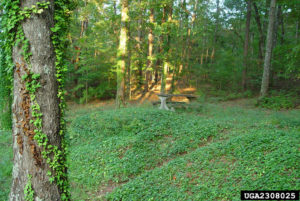Controlling English Ivy
go.ncsu.edu/readext?595295
en Español / em Português
El inglés es el idioma de control de esta página. En la medida en que haya algún conflicto entre la traducción al inglés y la traducción, el inglés prevalece.
Al hacer clic en el enlace de traducción se activa un servicio de traducción gratuito para convertir la página al español. Al igual que con cualquier traducción por Internet, la conversión no es sensible al contexto y puede que no traduzca el texto en su significado original. NC State Extension no garantiza la exactitud del texto traducido. Por favor, tenga en cuenta que algunas aplicaciones y/o servicios pueden no funcionar como se espera cuando se traducen.
Português
Inglês é o idioma de controle desta página. Na medida que haja algum conflito entre o texto original em Inglês e a tradução, o Inglês prevalece.
Ao clicar no link de tradução, um serviço gratuito de tradução será ativado para converter a página para o Português. Como em qualquer tradução pela internet, a conversão não é sensivel ao contexto e pode não ocorrer a tradução para o significado orginal. O serviço de Extensão da Carolina do Norte (NC State Extension) não garante a exatidão do texto traduzido. Por favor, observe que algumas funções ou serviços podem não funcionar como esperado após a tradução.
English
English is the controlling language of this page. To the extent there is any conflict between the English text and the translation, English controls.
Clicking on the translation link activates a free translation service to convert the page to Spanish. As with any Internet translation, the conversion is not context-sensitive and may not translate the text to its original meaning. NC State Extension does not guarantee the accuracy of the translated text. Please note that some applications and/or services may not function as expected when translated.
Collapse ▲Most southern gardeners have a love/hate relationship with English ivy (Hedera Helix). A common and attractive vine in the south, its aggressive climbing and clinging habit can cause damage to trees, buildings and the gardener’s back. Many a gardener has planted a small patch of ivy to enhance a trellis, garden wall or brick chimney, only to find that it is impossible to control once it has become established. It can pull up shingles and bring down trees if left alone to grow and flourish.
Control is possible but it isn’t an easy task and it doesn’t happen quickly. Timing is very important and now is the time to begin. There are multiple ways to control English ivy but no one, single method is foolproof. Most often success is achieved when a combination of techniques is used. Repeated mowing will eventually bring about good control but the mowing has to be frequent and thorough-at least every week or so throughout the growing season. This method will take a couple of years and even then, care must be taken to watch for regrowth.
To control English ivy in trees, simply cut the ivy at the base of the tree and pull whatever you can reach out of the tree. In time the higher vines will fall out. But, the ivy at the base of the tree must either be mown or sprayed with an herbicide. This will also take multiple applications.
Chemical control can work well but timing is the key to success as well as use of the proper chemical. Glyphosate offers good control when used properly. A true Roundup brand must be used and the plain 41% glyphosate formulation is best. Do not use any formulation that offers quick or extended control. Generic brands have not been as successful. Do not use Ready-to-Use products. Spring is the best time to start your applications. When you see several new leaves in the spring, start spraying. Use 5.1 ounces of 41 % Roundup per 1 gallon of water. Apply when rain is not expected for 24 hours. Re-apply in 6 weeks when regrowth is noticed. As summer deepens, control will become less effective. When spraying in mid-summer mow ivy first and then treat the regrowth.
English ivy is a perennial, woody vine and seeds can be spread by birds. Even when you think it is gone, continue to check for regrowth and treat whenever necessary. If you have additional questions, you can call the Extension office at 764-9480 for more information.
Photo: Chuck Bargeron, University of Georgia, Bugwood UGA2308025





